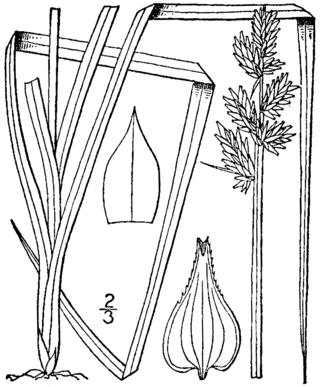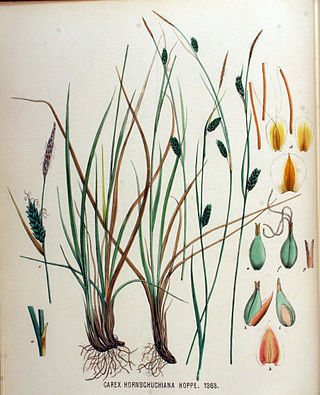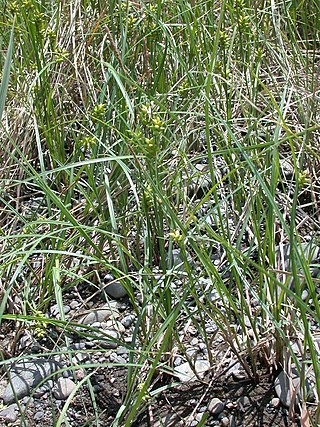
Francis Boott was an American physician and botanist who was resident in Great Britain from 1820.

Uncinia is a genus of flowering plants in the family Cyperaceae, known as hook-sedges in Australia and as hook grasses or bastard grasses in New Zealand. The genus is characterised by the presence of a long hook formed by an extension of the rachilla, which is used to attach the fruit to passing animals (epizoochory), especially birds, and it is this feature which gives the genus its name, from the Latin uncinus, meaning a hook or barb.

Pedicularis groenlandica is a showy flowering plant in the family Orobanchaceae commonly known as elephant's head, little pink elephant, elephantella, or similar common names inspired by the resemblance of the flower to the head of an elephant. It is also less commonly known as butterfly tongue for the long beak on the flower. Like many other plants in genus Pedicularis, it is a parasitic plant and depends on host plants to survive.

Carex comosa is a species of sedge known as longhair sedge and bristly sedge. It is native to North America, where it grows in western and eastern regions of Canada and the United States, and parts of Mexico. It grows in wet places, including meadows and many types of wetlands. Tolerates deeper water than most common species and is good for retention basins. This sedge produces clumps of triangular stems up to 100 or 120 centimeters tall from short rhizomes. The inflorescence is up to 35 centimeters long and has a long bract which is longer than the spikes. It is a cluster of several cylindrical spikes. The scales over the fruits taper into long, thin awns.

Carex rossii, commonly known as Ross's sedge, is a hardy species of sedge that is often a pioneer species in areas with little or no established vegetation, or in places where disturbance has occurred. Ross's sedge grows in a variety of habitats throughout much of western North America, from Alaska to Ontario, south to New Mexico and California. It flowers in May and June.

Carex archeri, known as Archer's sedge, is a species of sedge in the genus Carex, endemic to south-eastern Australia.

Carex adusta, commonly known as the lesser brown sedge or the browned sedge, is a species of sedge (Carex) in the section Ovales. First described scientifically in 1839 by Francis Boott, it is found in Canada and the northeastern United States, where it grows in dry, acidic, sandy soils. Adusta is Latin for "burnt," probably referring to the color.

Carex arctata, known as drooping woodland sedge, is a species of sedge native to eastern North America. It is sometimes called black sedge, compressed sedge, or drooping wood sedge. It occurs from Manitoba to the Maritimes in Canada, south to northwestern North Carolina, and west to Minnesota. Carex arctata grows in bogs, hardwood forests, and spruce forests.

Carex banksii is a species of flowering plant in the sedge family, Cyperaceae. Carex banksii is native to South America and was first formally named by Francis Boott in 1839.
Carex barbata is a Tasmanian species of sedge that was first formally named by Francis Boott in 1858, in his Illustrations of the genus Carex. A specimen collected in February 1839 by R. C. Gunn is the only known collection of this species. In 1909, it was reclassified as a variety of Carex gunniana, but Kew's Plants of the World Online maintains it as a separate species.

Carex capillacea, common name yellowleaf sedge in Tasmania, is a species of sedge found in Assam, the far east of Russia, New Guinea, south east Australia, New Zealand, Malesia, China, Japan and India.

Carex conjuncta, known as soft fox sedge, is a species of sedge that was first formally named by Francis Boott in 1862. It is endemic to the central and eastern United States.
Carex gunniana is an Australia species of sedge that was first described in 1845 by Boott in the Proceedings of the Linnean Society of London. It is native to eastern Australia and Tasmania.

Carex fascicularis, commonly known as tassel sedge, is a species of sedge of the family Cyperaceae that is native to Australia, New Zealand and New Guinea.

Carex hostiana, the tawny sedge, is a species of flowering plant in the genus Carex, native to Europe and northeast Canada, and extinct in Massachusetts. It is a member of the Carex flava species complex.

Carex breviculmis, called the Asian shortstem sedge, is a species of flowering plant in the genus Carex, native to Asia from the Indian subcontinent to Southeast Asia, China, Taiwan, Korea, Japan, north as far as Khabarovsk Krai, and Malesia, New Guinea, Australia, Norfolk Island and New Zealand. It has been introduced to the US state of Mississippi. Typically found in forests, it is quite shade tolerant.

Carex scabrifolia, also known as cao ye tai cao, is a tussock-forming species of perennial sedge in the family Cyperaceae. It is native to eastern parts of Asia.

Carex gaudichaudiana, also known as fen sedge, is a tussock-forming species of perennial sedge in the family Cyperaceae. It is native to parts of Australia and New Zealand.
Carex interrupta is a tussock-forming species of perennial sedge in the family Cyperaceae. It is native to south eastern parts of Canada and north eastern parts of the United States.
Carex acidicola is a tussock-forming species of perennial sedge in the family Cyperaceae. It is native to south eastern parts of the United States in Alabama and Georgia.















